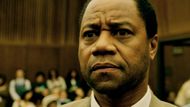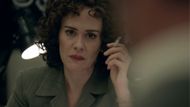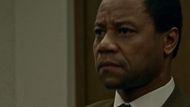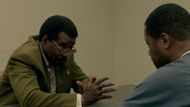American Crime Story: The People vs. O.J. Simpson aired in 2016. It revolves around the 1994 to 1995 O.J. Simpson murder trial. And the case became one of the most watched in American history.
It reveals the story of O.J. Simpson, a former football star, being accused of killing his ex-wife, Nicole Brown Simpson. They also accused him of killing her friend, Ronald Goldman. The series recreated real events using court transcripts and media footage. It combined factual information with dramatized scenes to keep the story engaging.
But viewers wanted to know which parts were real and which were written for drama. So, we'll navigate where truth ends and drama begins. Here, you can discover which moments were inspired by real life and which were crafted to evoke emotion.
American Crime Story: Which parts of The People vs O.J. Simpson were actually true

The real “Bronco Chase”
The show's dramatic police chase involving Simpson's white Ford Bronco happened on June 17, 1994. More than 95 million people watched it live on television. Simpson’s close friend Al Cowlings drove the car while Simpson sat in the back seat with a gun. Police followed for about two hours through the Los Angeles freeways.
The dialogue used in American Crime Story: The People vs. O.J. Simpson, where Simpson asks to see his mother before surrendering, was inspired by real police negotiations that day. The scene’s emotional intensity matched reality.
The famous glove test happened
Prosecutor Christopher Darden asked O.J. Simpson to try on the bloody gloves found at the crime scene. The gloves looked too small. That moment changed the trial. Defense lawyer Johnnie Cochran used the moment to his advantage. He told the jury, “If it doesn’t fit, you must acquit.” The phrase became famous across the country.
You saw that scene in American Crime Story: The People vs. O.J. Simpson exactly as it happened. The gloves had shrunk after being soaked in blood and frozen as evidence. That technical fact did not matter in the courtroom. The visual of Simpson forcing the gloves over his hands stayed in every juror’s mind.
Marcia Clark faced sexism

Marcia Clark led the prosecution in the O.J. Simpson trial. The media attacked her appearance instead of her arguments. Reporters wrote about her hair and clothes. Comedians mocked her on television. Headlines turned her into a public target.
The show portrayed her exhaustion and anger truthfully. Clark worked long hours and faced constant judgment. She later said the coverage humiliated her. The show shows how gender bias shaped the story. The trial showed how women in authority face unfair attention. Sarah Paulson’s performance in American Crime Story: The People vs. O.J. Simpson captured that pressure with honesty and restraint.
Johnnie Cochran’s charisma
Johnnie Cochran spoke with confidence and control. He argued with precision and emotion, focused on race as his main theme. He said O.J. Simpson was targeted by a corrupt system. He accused the Los Angeles Police Department of bias against Black citizens.
Rodney King faced police brutality in 1991. That event left deep anger and mistrust. In American Crime Story: The People vs. O.J. Simpson, Cochran used that history to connect with the jury. He mixed law with storytelling. His tone, timing, and energy shaped every hearing. And viewers see why he became the leader of the defense team. His words carried weight, and his strategy helped decide the verdict.
Robert Kardashian’s role was accurate but small
David Schwimmer played Robert Kardashian as a loyal friend under pressure. In real life, Kardashian stood close to O.J. Simpson and joined his defense team. The show showed his unease as cameras followed every move. That part was true. He went on live TV and asked people not to judge before hearing all the facts in 1994.
The American Crime Story: The People vs. O.J. Simpson made that conflict stronger to give the story more emotion. There is no record of Kardashian doubting Simpson’s innocence as deeply as shown on screen, and we learn how the show used real facts and mixed them with drama to show human tension.

Mark Fuhrman’s racist history was exposed
Detective Mark Fuhrman’s credibility collapsed during the trial. Tapes of him making racist remarks were played in court. This event gave the defense an advantage. American Crime Story: The People vs. O.J. Simpson portrayed Fuhrman as arrogant and racially biased. This portrayal matched descriptions from court reports. It also matched witness statements.
The court questioned Fuhrman about using racial slurs. He invoked his Fifth Amendment right and avoided answering the questions. This response destroyed his reputation.
Jurors were mentally exhausted
The jury was sequestered for about nine months. They were cut off from family, television, and newspapers. This was the longest jury sequestration in American history, lasting around 265 days. Many jurors became frustrated and tired.
American Crime Story: The People vs. O.J. Simpson depicted their boredom, tension, and disputes
Media Frenzy was completely real
The O.J. Simpson trial transformed news coverage forever. Every major network covered it daily. Cameras followed every move of the lawyers, witnesses, and even the families of the victims. Talk shows debated it nonstop.
The American Crime Story: The People vs. O.J. Simpson recreation of crowded press conferences, flashing cameras, and tabloid headlines was completely true. It was not just a legal event but a global media spectacle.
The relationship between Marcia Clark and Chris Darden
The friendship between prosecutors Marcia Clark and Chris Darden felt genuine, both real and reel. They shared mutual respect and trust. Many viewers suspected romance, but both have maintained their bonding as colleagues.
The warmth shown between them in the American Crime Story: The People vs. O.J. Simpson was inspired by real teamwork and emotional support, not confirmed romance.
Public reaction to the verdict was true
When the jury announced “not guilty” on October 3, 1995, reactions across America were sharply divided. Many Black Americans saw it as justice against years of police abuse, while many White Americans believed it was a failure of the legal system. Polls at the time showed that around 70 percent of Black respondents supported the verdict, while most White respondents disagreed.
The American Crime Story: The People vs. O.J. Simpson final scenes, showing joy, anger, and disbelief, captured that cultural divide.
O.J. Simpson’s life after the trial

The show ended with Simpson lonely and isolated. This reflected his real life. He was acquitted of murder but lost public respect. Many friends left him. A civil court found him liable for the deaths in 1997. The court ordered him to pay millions in damages. And he was convicted of armed robbery in Las Vegas ten years later. Then, he was sentenced to prison. His fame became infamy.
What the American Crime Story: The People vs. O.J. Simpson Got Right
The series got most major events right. The Bronco chase, the glove test, Cochran's courtroom dominance, and Marcia Clark's mistreatment, the exposure of Mark Fuhrman, all were factual. The production team used court transcripts, they used news reports, and interviews. This kept accuracy high.
American Crime Story: The People vs. O.J. Simpson stayed close to reality. It kept the tension alive, told the story of a trial that divided America. It showed how race, fame, and media shaped justice in the 1990s.
You see, the show used facts as the Bronco chase came from real events. The glove test came from real events. The courtroom scenes came from real events. The actors mirrored the real people. So, the lesson is that facts hold more drama than fiction.
